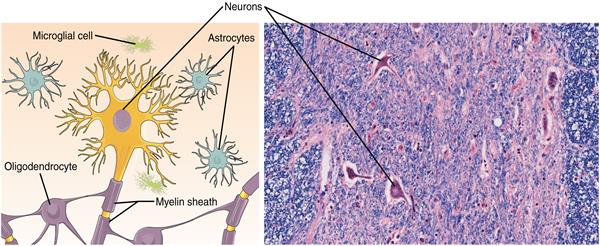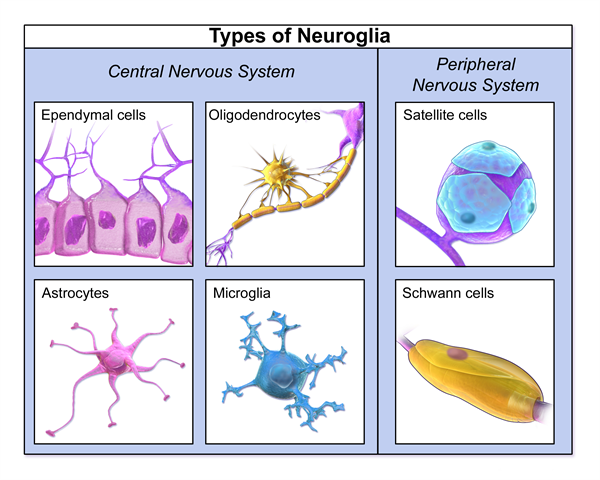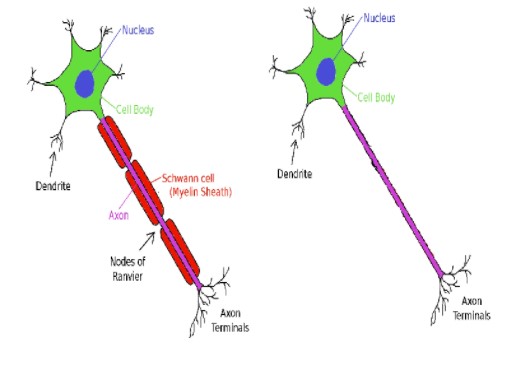PDF chapter test TRY NOW
We should understand certain terminologies and their meanings before learning about the nervous systems.
Nomenclature:
- Ganglion - A ganglion is a collection or group of nerve cell bodies.
- Neurons – Specialised cells that transport chemical and electrical information from one location to another
- Sensory neurons - Sensory neurons synapse with interneurons to transmit information about the external and internal environments from sensory receptors to the CNS.
- Motor neurons - Motor neurons transmit impulses from the central nervous system to effector cells.
- Interneurons - Interneurons, found within the CNS and only connect with other neurons, integrate sensory and motor input.
- Synapses - A nervous system can be regarded as a well-organised collection of neurons that communicate through synapses or contact points. Synapses are points where the membranes of two or more neurons come very close together and are connected by specialised membrane characteristics.
- Sensory input - Sensory input is the transmission of messages from sensory receptors to the nervous system’s integration centres.
- Motor output - The transmission of signals from the processing centre to effector cells like muscle and gland cells that carry out the body’s response to stimuli is known as motor output.
Do you know the nerve fibre network in the brain is about 500,000 km long? This much length is longer than the distance between Earth and the Moon.
The axon of the neuron determines the length of the nerve fibre. The nervous tissue that makes up the nerve fibres comprises different types of components as explained below.
Nervous system:

Nervous tissue
Nervous tissues make up the nervous system. Except for microglia, which originate from the mesoderm, neural tissue develops from the embryo's ectoderm. It is found throughout the body. Neural tissue is formed of three distinct components, namely,
- Neurons
- Neuroglia
- Nerve fibres
1. Neuron or nerve cell:

Structure of neuron
Nervous tissues, which make up the nervous system, communicate in a variety of ways and are one of the human body's most mysterious and complicated systems. The characteristics of the nerve cells are listed below;
- The structural and functional unit of the nervous system is the neuron.
- A nerve cell that has been injured cannot be repaired because, unlike other tissues (E.g. skin), nerve cells cannot replicate and do not reproduce after birth.
- Nerve cells, called neurons, are the longest cells of the human body, measuring over 100 mm in length.
- Neurons generate action potentials, electrical signals that allow them to send information over large distances fast.
- Nerve cells send out messages called nerve impulses at a rate of 100 metres\ per\ second.
- The neuron is the fundamental functioning unit of the brain. These are specialised cells that transmit information to other nerve cells, muscle cells, and gland cells.
- Electrical impulses are used to transmit information from one part of the body to another through neurons.
- Nerve cells are highly specialised in their ability to detect, receive, and transmit various stimuli.
2. Neuroglia:
Glial cells are another name for neuroglia. The brain and spinal cord contain neuroglial cells. They are non-exciting cells that support neurons and their fibres in the nervous system. Nerve impulses are not initiated or conducted by them. More than half of the volume of neural tissue in the human body is made up of neuroglia.
Neuroglia is divided into six types, with their own set of functions:
- Astrocyte
- Oligodendrocyte
- Microglia
- Ependymal cell
- Satellite cell
- Schwann cell

Types of neuroglia
1. Astrocytes:
Astrocytes derive their name from the fact that they are formed like stars. They are the most common glial cells in the brain, and they are associated with neuron synapses.
Functions of astrocytes:
- They control how electrical impulses are transmitted in the brain.
- They aid in the regulation of blood flow in the brain.
- They maintain the fluid composition around neurons and the regulation of synaptic communication.
- Astrocytes help neurons navigate and contribute to form the blood-brain barrier, which shields the brain from potentially hazardous substances in the blood throughout development.
2. Oligodendrocytes and Schwann cells:
The oligodendrocytes in the CNS and the Schwann cells in the PNS both play similar roles. These types of glial cells generate myelin, an insulating material that forms a sheath around the axons of many neurons. Myelin is necessary for nervous system activity because it speeds up the transmission of an action potential down the axon.
3. Satellite glial cells:
In the PNS, satellite glial cells line the outside of neurons and surround the neuron cell bodies or cyton within ganglia. Their exact function is unknown; however, they are considered to give nutritional support and protection.
4. Ependymal cells:
Ependymal cells are basic cuboidal cells that line the ventricles of the brain and the central canal of the spinal cord. Its free surface is covered in microvilli and cilia. Microvilli aid in the absorption of cerebrospinal fluid. The movement of cilia facilitates the flow of CSF fluid.
3. Nerve fibres:

Myelinated and non-myelinated neurons
The long, slender processes of neurons (axons) are known as nerve fibres. Nerves are made up of a group of nerve fibres that are bundled together.
Axon forms nerve fibres, and they are of two types.
- Myelinated nerve fibres
- Non-myelinated nerve fibres
Important!
Note: We will study these nerve fibres in the following theoretical material.
Reference:
https://upload.wikimedia.org/wikipedia/commons/a/a6/Blausen_0870_TypesofNeuroglia.png
https://upload.wikimedia.org/wikipedia/commons/0/0b/416_Nervous_Tissue-new.jpg
https://upload.wikimedia.org/wikipedia/commons/b/b5/Neuron.svg
https://upload.wikimedia.org/wikipedia/commons/8/88/Myelinated_unmylinated_neurons.PNG
